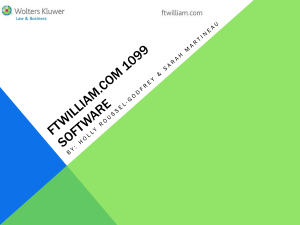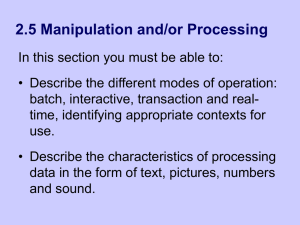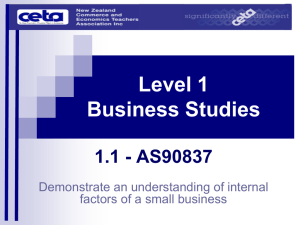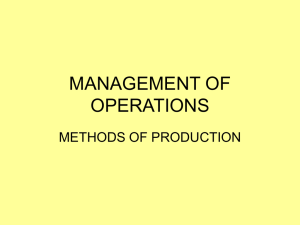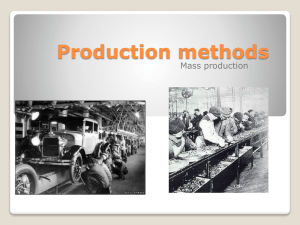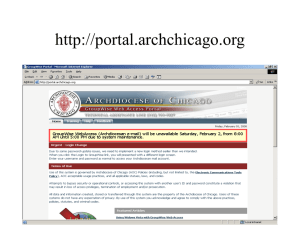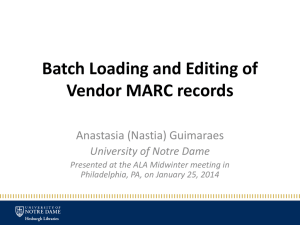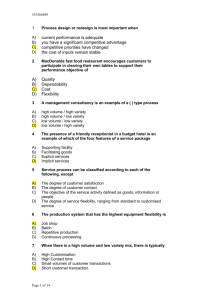product
advertisement
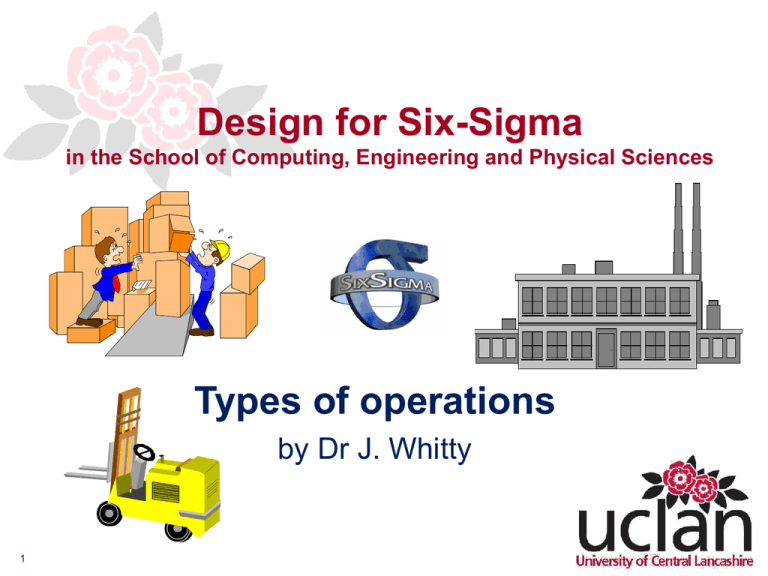
Design for Six-Sigma in the School of Computing, Engineering and Physical Sciences Types of operations by Dr J. Whitty 1 Lessons structure • The lessons will in general be subdivided in to eight number of parts, viz.: 1) 2) 3) 4) 5) 6) 7) 8) 2 Statement of learning objectives Points of orders Introductory material (Modes of organization) Concept introduction (Product life cycle stages) Development of related principles (Flow processes) Concrete principle examples via – reinforcement examination type exercises Summary and feedback Formative assessment, via homework task Learning objectives • Principles of operational process management apply to services and manufacturing. • compare jobbing, batch and flow process approaches to work organisation • see how these apply to work in services and manufacturing • Specifically, describe the usage of types of operations in Nuclear decommissioning • Answer Examination type questions involving production processes 3 Examination Type Questions 1. 4 (5) Carlton Press Ltd is a small publishing company specialising in educational books. Draw a diagram showing the typical stages of production and distribution of one of its books. Basic modes of organising work How can operations/jobs be done? • • • • • Jobbing (jumbled flow) Project Batch (disconnected line flow) Assembly line (connected line flow) Continuous flow process Advantages/disadvantages of each. Most processes combine two or more. Choice based on experience, organisation skills, investment, practicality and economy 5 Product Life Cycle Stages 1. Low volume, low standardization, one of a kind 2. Multiple products, low volume 3. Few major products, higher volume 4. High volume, high standardization, commodity product 6 Class discussion • Name the five types of production processes present in modern day manufacturing – Give an example of each used in a real manufacturing company. – Give an advantage and disadvantage of each of the processes identified – Name a management method of control of each of these processes 7 Jobbing • All tasks performed by the same person. One part of the task is completed before the next starts. • multi-skilled operatives required: all equipment, manual abilities, artistic competence and decision-making. • A project with a “team” which combines to complete the whole is a more complex jobbing activity. Class Exercise: Find on the internet two companies which operate primarily a Jobbing production regime 8 Jobbing • Non-Repetitive, Customised production enhances value > diminishes it. Several multi-skilled people may produce the same product. Organisation & control to ensure key product features at every repetition. Quantities small & to customer spec. • Equipment Basic craft tools. Key equipment shared & scheduled. Equip't waiting time - a key factor. • Costing of products labour + materials + overheads. ----> selling price . Premium prices for uniqueness, workmanship & materials quality. 9 Batch operation The work done in batches with separate, sequential operations. Example 1 – collect your dirty washing as two loads (5 minutes) – Put Batch A in the washing machine. – When washed, dry batch A in tumble drier while batch B is washed. – When A is dry, B can be dried whilst A is ironed. – B is then ironed – 15 mins to wash batch, 12 mins to dry, 35 mins to iron a batch Example 2 – prepare and cook 235 breakfasts to be served on Quantas flight QT567K to Melbourne 10 Flow Process • Not all work done in batches. • Commercial dish washing machines & factory biscuit baking ovens incorporate a feed conveyor belt. Dirty plates or biscuits are washed or baked in a smooth non-stop operation (flow). 11 Line Flow WS 1 WS Task or work station Product flow 12 WS 2 WS 3 Batch Production Shop • • • • Similar layouts + equipment to job shop. Batch progress in stages. Work done by one person or team at workstation then moves on Separation of design, planning & scheduling – Order received & work systematically defined & organised. Drawings, tools, staffing – main assemblies, subs & components etc. – Ops for each part/assembly, machines/workstations where work occurs + timing of each step • Materials supplied to workstation for the batch. • WIP - When item 1 n process, the rest queue 13 Batch Flow WS 2 WS 1 WS WS 3 Task or work station Product flows 14 WS 4 WS 5 Class Exercise: Find on the internet two companies which operate primarily a batch production. Batch operations information system • systematic recording, storage, access & dissemination of batch operations data: instructions, progress & work changes • Managers, industrial engineers, planners examine efficiencies & update operational specifications • Computers & database systems, documented procedures & meticulous administrators • Operators carry out the work - set ups, quality, JIT etc 15 Data collection and Batch analysis • • • • optimum batch sizes ? No “one right answer”. hundreds of batches in progress - each with different status production control records to track every batch. high levels of “work in progress” (variety of work and batch hold ups). • data collection points and logging • bar code scanning for up-to-the-minute analysis: delays, bottlenecks, lost time, quality problems and costs. 16 Batch costs & resource utilisation • large, inflexible, expensive items of equipment? • Large batch sizes reduce average set up costs/unit Objectives – – – – reduce change-over times and set-up costs. high utilisation of people and key equipment insert new jobs with minimum interruption Hit deadlines, improving work methods especially for repeat jobs – lowest cost operations with minimum down time, high quality and customer service. • Competitive aim = take smaller orders, give better prices, quality and responsiveness. • Flexibility: CAD, CAM/CNC, cell technology 17 Batch processing applies to services also. • data processing (payroll, trial balance runs, master file updating) on corporate computers? • lunch & sandwich making in a college cafeteria? Hamburgers & chips in a fast-food restaurant? • Flying eye-operation theatre? • Today's patients at out-patients' clinic? • processing of tax demands sent out to individuals? • How are car repairs done in a garage? • Baggage handling at an airport • Preparing dinner for 2/3 people vs. a wedding buffet for 150? • assembly of TVs., PCs, cars, flat-pack furniture 18 Flow Production • manufacturing or assembly process where work done on a product in a steady, sequence as it moves along a track. • The track does not stop (no idle time). • Operators, at work stations, perform tasks on the product as it passes thru. the workstation. • Line dedicated to one product . No “batch” as such. • A flexible continuous flow line may be capable of switching to a model or product variant. 19 Capacity and Demand Variations • Track speed determines through-put capacity. • Speed governed by slowest point on the line - (bottleneck). • Production planning to balance line capacity with demand. • +/-staffing levels, overtime, extra shift, make for stock 20 Investments & costs - expensive dedicated flow line • • • • • • • • 21 Downtime ---> no feed to down-stream clients. Poor quality at a station continues down the line. Rectifying faults at line end is expensive Upstream servers need holding areas to keep going Rapid response repair & planned maintenance systems Manage supply to stations – MRP or Kanban/JIT operations at stations benefit from work study Control product changes & equipment installation/maintenance - to avoid disruption Flow Process Staffing and Skills • Operators- skilled/trained only for tasks at workstation? • Simpler recruitment & training but routinised and repetitive. Little operator discretion over speed/sequence of work and methods. • Technology determined - limited scope for line worker interaction . • Operators must be high focused + work rhythm • Alienation with routine, continuous, pace???? 22 Job re-design & group/cell technology • From late 60s - job flexibility & empowerment e.g. Herzberg & Volvo • team at a work statio n- a “cell” - manage own activities, roles & methods • multi-skilling, job rotation & QA by by team itself. • re-engineer how technology is implemented. – adapt technology to people - not viz. – Form cells (workstations) where work can stop & operators (team) can do a series of tasks • “Team” emphasis - group problem-solving supported by specialists & management when needed. 23 Project Flow Task 2 Task 4 Start End Task 1 Task Task or activity Precedence relationship 24 Task 3 Group Discussion: Given these definitions in your buzz groups agree on two criteria in order decide where and when each of the processes should be employed. Hence produce a pictorial process selection chart, based on these criteria. 25 Group Discussion: Service Analogues There are two service model analogues, these being proposed by two different authors, these being: The tri-process model (Greasley,2009*) The four process model (Lovelock, 1992) In your buzz groups discuss the expressions, via the use of cogent examples Professional service, Service shop and Mass service Hence describe three and four service model analogues to those described in the lecture, via defining the term Service factory, via the use of a Variety/Volume chart. 26 *Secondary source! Group Discussion: Service Analogues There are two service analogues proposed are The tri-process model (Greasley,2009*) The four process model (Lovelock, 1992) includes a service facttory, The analogues are usually described ion terms of specific layout-designs: Mass Batch Jobbing Project Fixed Position Continuous Process Cell Professional Shop 27 Mass Product Short Answer Examination Type Questions 1. What product is produced in Nuclear Decommissioning? (1) 2. What is meant by the term Deindustrialisation? (1) 3. State three principal types of operational processes employed in nuclear decommissioning (3). 4. The disposal of nuclear waste can be viewed as a hybrid business sector activity, give examples of this by completion of the following table Kind of business activity Definition Example Primary Secondary Tertiary 28 (5) Summary • Have we met our learning objectives, namely Session Objectives • compare jobbing, batch and flow process approaches to work organisation • see how these apply to work in services and manufacturing • Specifically, describe the usage of types of operations in Nuclear decommissioning • Answer Examination type questions involving production processes 29 Homework: Examination Essay Type Questions 5. Write an essay of 1000-1200 words describing how nuclear decommissioning operates within three principal business operational sectors, explaining the organisation of specific operational processes used. With reference to front and back office actives describe the possible the use of the so called three-process and four-process models within the industry (35) 30
